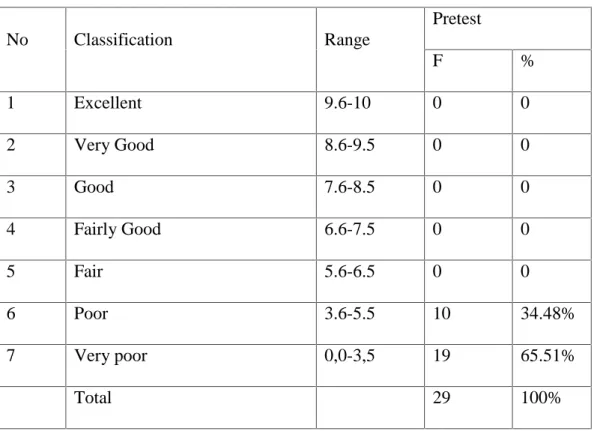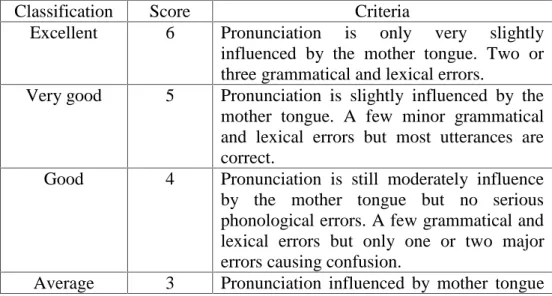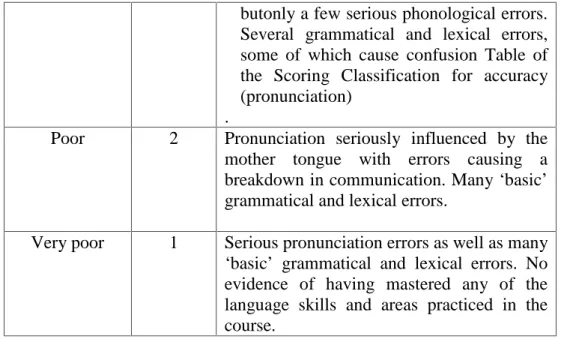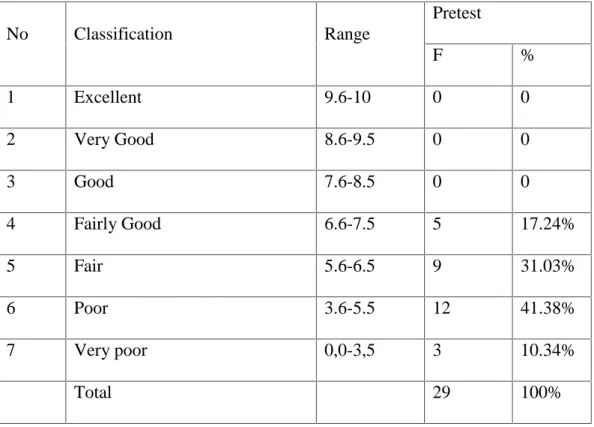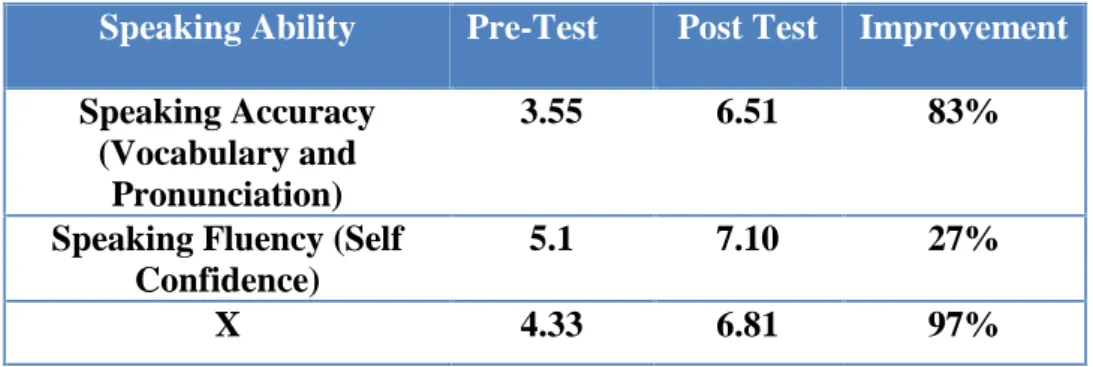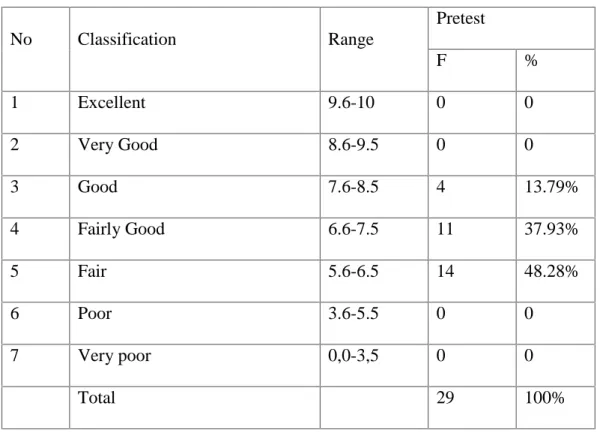English.Btlucation Departure Strata 1 (S1) . Fatulty: of Teacher Training and Education Elicitation Technique used by teachers with speaking skills at MAN I Lappariaja, Experimentaf ftudy). Speaking skills in the second year student of MAN 1 Lappariaja Kabupaten Bone (an experimental study). This study aimed to find out that the use of elicitation technique can improve student speaking skills among the second year students of MAN 1 Lappariaja.
It was emphasized on improving students' speaking skills by using elicitation technique. The results of this research were that the students' development in speaking ability was 4.33 in Pre-test and then 6.81 in Post-test. The speaking accuracy was 3.55 in the pre-test and then became 6.51 in the post-test, the students' development to Speaking Accuracy was 83%.
While the Speaking Fluency was 5.1 in the pre-test, then it became 7.10 in the post-test, the students' development in Speaking Fluency was 27%. This means that Extraction Technique was effective technique in teaching English speaking skill to the second year student of MAN 1 Lappariaja.
INTRODUCTION
- Background
- Problem Statement
- Objectives of the Research
- Significance of the Research
- Scope of the Research
How is the speaking ability of students before they were taught using Elicitation Technique on second year students in MAN 1 Lappariaja. How is the students' speaking ability after teaching using the Elicitation Technique to 2nd year students in MAN 1 Lappariaja. Knowing the students' speaking ability before they were taught using Elicitation Technique on second year students in MAN 1 Lappariaja.
To know the speaking skills of the students after teaching the elicitation technique to the second year student of MAN 1 Lappariaja. To know the significant difference in speaking skills of students before and after teaching using elicitation technique to the second year student of MAN 1 Lappariaja. Teachers can enrich their expressions so that they can be used in the classroom to improve students' speaking skills.
This research was limited to the use of elicitation technique to improve students' speaking ability. It focused on students' speaking accuracy consisting of pronunciation and vocabulary; and fluency which consisted of self-confidence.
REVIEW OF RELATED LITERATURE
Previous Related Research Findings
Based on the previous finding above, the researcher would like to compare the results above, they have used Elicitation Technique in their research but they have different focus. Nurrokhmah focuses on the kind of elicitation technique that the teacher uses to get the student to speak. Then, Stephen focuses on the application of the Elicitation Technique in student-teacher communication by asking some questions to get answers.
While Shadap at.al focuses on the application of elicitation technique in the Department of Computer Science and Engineering. All the above research agrees that the elicitation technique used by the teacher should not be denied. It can be a good tool to maintain classroom interaction and make the student courageous to communicate with others in the classroom.
Meanwhile, research is focused on the elicitation technique used by the teacher and the responses shown by the student.
Some Pertinent Ideas
The way the teacher gets the students to talk about his instruction is called elicitation. Clearly, elicitation serves two functions: they allow the teacher to determine whether students have learned the lesson and complement the content of the lesson by reinforcing students' correct answers and demonstrating the correct answer to students whose answers are incorrect. Speaking is, in addition to listening, reading and writing, one of the four basic skills when learning a foreign language.
It is the most essential way the speaker can express himself through language. Widdowson (2002:52) states that the act of speaking in natural communication interaction involves the use of vocal organs to produce sound and also the use of gestures, the movement of the muscles of the face and even of the entire body. It is described as one level similar to that of the students if it can just be understood.
Speaking is about understanding how context influences the choice of language used. Null hypothesis (H0): the second year students of MAN 1 Lappariaja are not able to improve the students' speaking skills by using the elicitation technique.
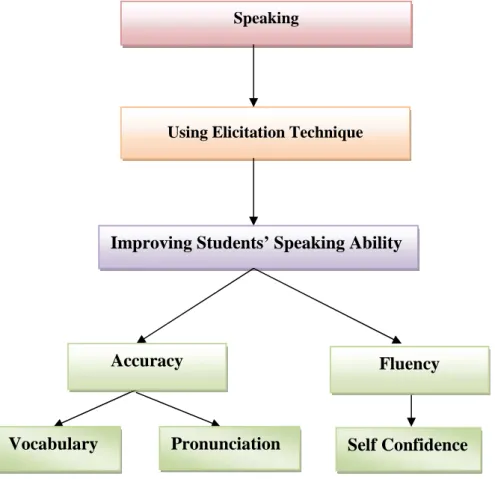
Research Design
Population and Sample
Variables and Indicator
Instrument of the Research
Data Collection
The researcher took one class of the second year students in the academic year of 2015/2016, namely XI IPA 1. So far the researcher wanted to see the prior knowledge of the students and also the students' ability to speak. In this activity it had scenario learning process based on elicitation technique used by teacher to improve students' speaking ability.
The function of the post-test was to know the student's knowledge and ability after teaching the use of the elicitation technique. Very Poor 1 They speak very hastily and several sentences are inappropriate using vocabulary and little or no communication. Several grammatical and lexical errors, some of which are confusing Accuracy (pronunciation) scoring classification table.
No proof of having mastered any of the language skills and areas practiced in the course.
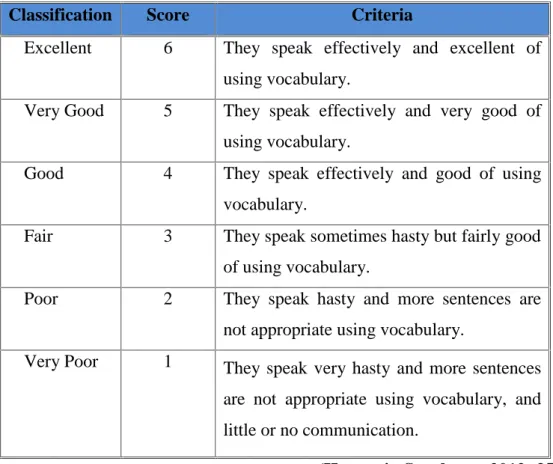
Technique of Data Analysis
Determining students' mean scores both pre-test and post-test. Determining the significant difference between students' mean score by calculating the t-test value.
FINDINGS AND DISCUSSION
Findings
- The students’ Speaking Ability Before Taught by
- The students’ Speaking Ability After Taught by
- Test of Significance (t- test) in Speaking Ability . 35
The result of the data analysis of the pre-test of the students' speaking ability on speaking accuracy, showed by the average score of indicator in the table above. From the average score above, the researcher also gave the score classification of the students' pre-test in accuracy and fluency. The result of the students' speaking ability in pre-test was classified as poorly categorized.
The result of the students' speaking ability in accuracy of which the indicators vocabulary and pronunciation and fluency with indicator confidence in post-testing are presented in the table below. The result of the data analysis of post-test of the students' speaking ability on speaking accuracy shown by the average score of indicator in the table 4.4 above. The average score of students' speaking ability was the result of the calculation of both indicators was 4.33 in pre-test and 6.81 in post-test with 97% percentage.
This means that the students' speaking ability developed after being treated through the use of elicitation technique. This means that the students' speaking ability developed after being treated through the use of elicitation technique. From the average score above, the researcher also gave the score classification of the students' post-test in accuracy and fluency.
From the description of the data collected using the speaking test, which was explained in the previous section, it was found that the students' speaking accuracy and fluency during the speaking pre-test were of poor category. The students' average score for speaking accuracy was 3.55, and the students' average score for speaking fluency was 5.1. From the description of the data collected using the speaking test, which was explained in the previous paragraph, it was found that the students' speaking accuracy and fluency increased during the speaking post-test.
The students' average speaking accuracy score was 6.51, and the students' average speaking fluency score was 7.10. The average score of students' speaking ability, which was the result of the calculation of both indicators, was 4.33 in the pre-test and 6.81 in the post-test with a percentage of 97%. It is supported by the frequency and percentage rate of the student's pretest and posttest scores.
The result of calculating the t-test of the indicator was that the students' t-test for speaking ability was greater than the t-table (107.8>2.048). It means that students' speaking skills are significantly developed after students are treated using elicitation technique in speaking. By seeing the change in students' developmental classification, it was found that using the elicitation technique had developed students' speaking skills.
Dengan Judul: Elicitation technique used by teacher to improve students' speaking ability at MAN 1 Lappariaja, Kabupaten Bone (An Experimental Study).
